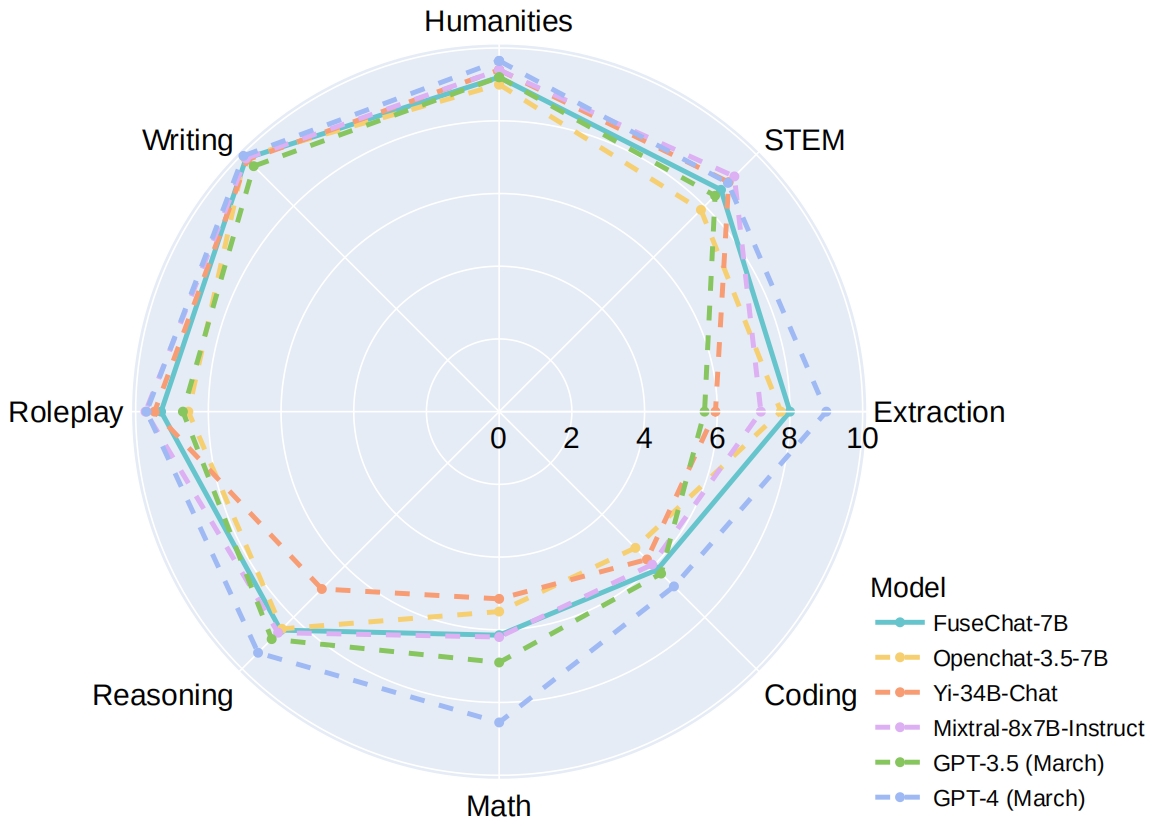FuseChat: Knowledge Fusion of Chat Models
_**Fanqi Wan, Ziyi Yang, Longguang Zhong, Xiaojun Quan, Xinting Huang, Wei Bi**_
_Sun Yat-sen University_

| Proprietary Models | #Params | MT-Bench | Open Source Models | #Params | MT-Bench |
|-----------------------------------------------------------------------|---------|----------|-----------------------------------------------------------------------|---------|----------|
| GPT-4-1106-preview | - | 9.32 | Qwen1.5-72B-Chat | 72B | 8.61 |
| GPT-4-0613 | - | 9.18 | Nous-Hermes-2-Mixtral-8x7B-DPO | 8x7B | 8.33 |
| GPT-4-0314 | - | 8.96 | Mixtral-8x7B-Instruct-v0.1 | 8x7B | 8.30 |
| Mistral Medium | - | 8.61 | 🤗 [FuseChat-7B-VaRM](https://huggingface.co/FuseAI/FuseChat-7B-VaRM) | 7B | 8.22 |
| GPT-3.5-Turbo-0613 | - | 8.39 | Starling-LM-7B-alpha | 7B | 8.09 |
| GPT-3.5-Turbo-1106 | - | 8.32 | Tulu-2-DPO-70B | 70B | 7.89 |
| 🤗 [FuseChat-7B-VaRM](https://huggingface.co/FuseAI/FuseChat-7B-VaRM) | 7B | 8.22 | OpenChat-3.5 | 7B | 7.81 |
| Claude-2.1 | - | 8.18 | OpenChat-3.5-0106 | 7B | 7.80 |
| Claude-2.0 | - | 8.06 | WizardLM-70B-v1.0 | 70B | 7.71 |
| GPT-3.5-Turbo-0314 | - | 7.94 | Yi-34B-Chat | 34B | 7.67 |
| Claude-1 | - | 7.90 | Nous-Hermes-2-SOLAR-10.7B | 10.7B | 7.66 |
## News
- **Feb 26, 2024:** 🔥🔥 We release [FuseChat-7B-VaRM](https://huggingface.co/FuseAI/FuseChat-7B-VaRM), which is the fusion of three prominent chat LLMs with diverse architectures and scales, namely [NH2-Mixtral-8x7B](https://huggingface.co/NousResearch/Nous-Hermes-2-Mixtral-8x7B-DPO), [NH2-Solar-10.7B](https://huggingface.co/NousResearch/Nous-Hermes-2-SOLAR-10.7B), and [OpenChat-3.5-7B](https://huggingface.co/openchat/openchat_3.5). FuseChat-7B-VaRM achieves an average performance of **8.22** on MT-Bench, outperforming various powerful chat LLMs at 7B and 34B scales like [Starling-7B](https://huggingface.co/berkeley-nest/Starling-LM-7B-alpha) and [Yi-34B-Chat](https://huggingface.co/01-ai/Yi-34B-Chat), even surpassing [GPT-3.5 (March)](https://platform.openai.com/docs/models/gpt-3-5-turbo), [Claude-2.1](https://www.anthropic.com/news/claude-2-1), and approaching [Mixtral-8x7B-Instruct](https://huggingface.co/mistralai/Mixtral-8x7B-Instruct-v0.1).
- **Feb 25, 2024:** 🔥 We release [FuseChat-Mixture](https://huggingface.co/datasets/FuseAI/FuseChat-Mixture), which is a comprehensive training dataset covers different styles and capabilities, featuring both human-written and model-generated, and spanning general instruction-following and specific skills.
## Contents
- [Overview](#overview)
- [Model Release](#model-release)
- [Quick Start](#quick-start)
- [Data Construction](#data-construction)
- [Pairwise Knowledge Fusion](#pairwise-knowledge-fusion)
- [Model Merging](#model-merging)
- [Evaluation](#evaluation)
- [Citation](#citation)
## Overview
In this work, we propose an extended framework of FuseLLM to integrate the collective knowledge and individual strengths of multiple structure and scale-varied chat LLMs into a more powerful chat LLM, resulting in FuseChat. FuseChat adopts a fuse-then-merge strategy with two main stages. Firstly, it undertakes pairwise knowledge fusion for source LLMs to derive multiple target LLMs of identical structure and size via lightweight fine-tuning. Then, these target LLMs are merged within the parameter space, wherein we propose a novel method VaRM for determining the merging weights based on the variation ratio of parameter matrices before and after fine-tuning.
Moreover, we argue that the concept of knowledge fusion adopted by both FuseChat and FuseLLM shares a fundamentally similar purpose with other related topics, such as the recently popular topic of mixture of experts (MoEs), because they all aim to leverage the strengths of multiple models (experts). However, while MoEs require loading multiple experts during inference, which has higher memory requirements, knowledge fusion supports the integration of multiple LLMs with diverse architectures into a single LLM without any additional memory requirement, making it more memory-efficient.



